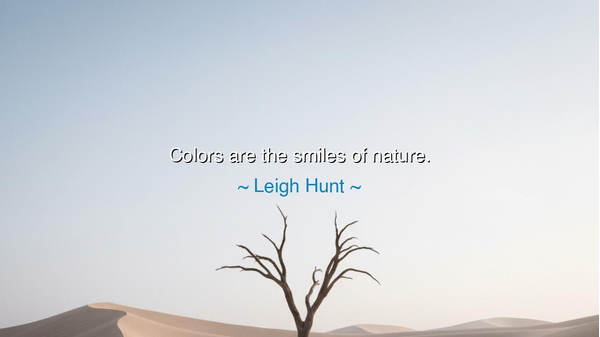
Colors are the smiles of nature.






Hear the luminous words of Leigh Hunt, poet of beauty and simplicity, who declared: “Colors are the smiles of nature.” In this saying, he gifts us a vision of the world alive, radiant, and joyful. For just as the human face brightens in delight, so too does the earth reveal its gladness through its hues. The green of spring’s new leaves, the gold of dawn’s first light, the crimson of the rose, the violet of twilight—all are but smiles upon the countenance of nature, expressions of her vitality and her eternal generosity to humankind.
The ancients would have understood this as divine truth. To them, the gods revealed themselves in the splendor of creation. The rainbow was no mere arc of light, but Iris, messenger of heaven. The flaming red of sunset was Helios descending in his chariot, smiling upon the day’s labors. The earth’s colors were never seen as accident, but as language—the living speech of nature, who could not remain silent but must proclaim joy and renewal through her smiles. Leigh Hunt, centuries later, echoes this sacred vision, urging us to see the world not as mere matter, but as a living soul adorned with light.
History, too, offers its witnesses. Think of Vincent van Gogh, the painter who wrestled with despair, yet found in colors the laughter of life. To him, the yellow of sunflowers was not just pigment but hope itself, a radiant smile from the earth that even sorrow could not erase. His canvases cry out the truth of Hunt’s words: colors are the balm of the spirit, the vivid gestures by which nature reminds us of her enduring joy.
Consider also the moment after a long and violent storm, when the sky clears and a rainbow arcs across the heavens. To those who endured the wind and thunder, that sudden burst of color feels like a promise, a smile of reassurance that the darkness has passed. For generations, sailors, farmers, and wanderers saw in the rainbow the earth’s laughter after her tears. This is the very heart of Hunt’s phrase: colors are not random—they are nature’s smiles, the signs of her life and love.
The meaning of Hunt’s words is therefore clear: to perceive the colors of the world is to perceive the joy of existence itself. Gray stone, without life, is silent; but when spring paints the meadow, when autumn robes the trees in fire, when the sea glimmers blue beneath the sun, we behold smiles—life proclaiming its presence and delight. The wise soul, then, does not merely look but sees, recognizing that every shade is a message of gladness written across creation.
The lesson for us is profound: learn to see colors not merely with the eyes, but with the heart. Let the blue of the sky remind you of peace, the green of the earth remind you of growth, the red of the rose remind you of passion and love. These are not trivial things—they are smiles meant to sustain the soul. To ignore them is to live blind amidst abundance; to see them is to live in harmony with nature’s joy.
Practical action flows naturally: seek out beauty, and do not hurry past it. When the sun sets, pause to let its colors warm your spirit. When flowers bloom, see in them not only petals but smiles. Bring color into your own life—clothe yourself, surround yourself, and share with others the brightness that stirs hope. For just as nature smiles upon us, so too can we smile back upon the world, painting our days with kindness and love.
Thus let Leigh Hunt’s words be carried forward: “Colors are the smiles of nature.” For in them we are reminded that the earth itself is alive, that beauty is the language of creation, and that every hue is a sign of joy. Let us walk, then, not as wanderers in a dull world, but as guests in a palace whose walls are painted with eternal smiles.






AAdministratorAdministrator
Welcome, honored guests. Please leave a comment, we will respond soon